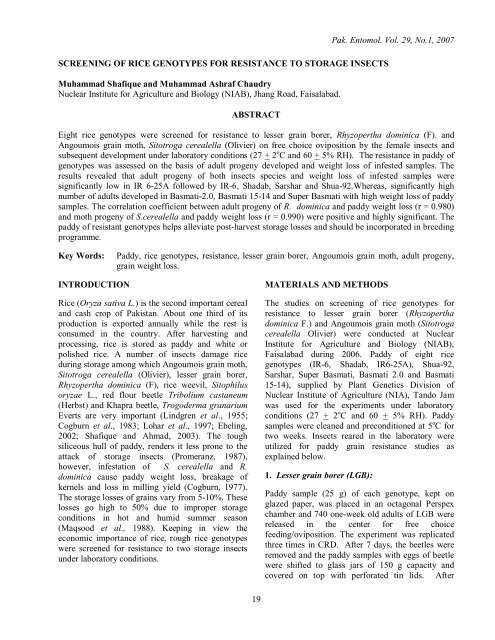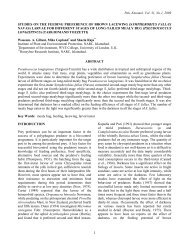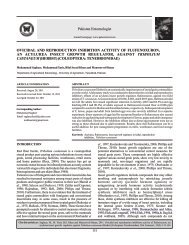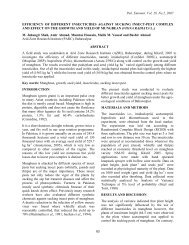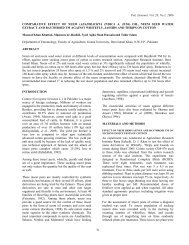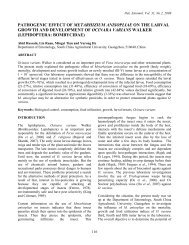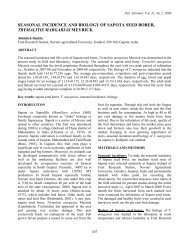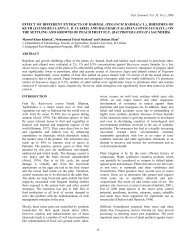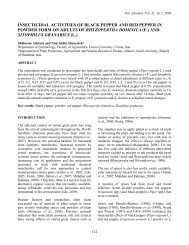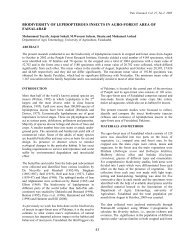screening of rice genotypes for resistance to storage insects
screening of rice genotypes for resistance to storage insects
screening of rice genotypes for resistance to storage insects
You also want an ePaper? Increase the reach of your titles
YUMPU automatically turns print PDFs into web optimized ePapers that Google loves.
SCREENING OF RICE GENOTYPES FOR RESISTANCE TO STORAGE INSECTS<br />
Muhammad Shafique and Muhammad Ashraf Chaudry<br />
Nuclear Institute <strong>for</strong> Agriculture and Biology (NIAB), Jhang Road, Faisalabad.<br />
ABSTRACT<br />
Pak. En<strong>to</strong>mol. Vol. 29, No.1, 2007<br />
Eight <strong>rice</strong> <strong>genotypes</strong> were screened <strong>for</strong> <strong>resistance</strong> <strong>to</strong> lesser grain borer, Rhyzopertha dominica (F). and<br />
Angoumois grain moth, Si<strong>to</strong>troga cerealella (Olivier) on free choice oviposition by the female <strong>insects</strong> and<br />
subsequent development under labora<strong>to</strong>ry conditions (27 + 2 o C and 60 + 5% RH). The <strong>resistance</strong> in paddy <strong>of</strong><br />
<strong>genotypes</strong> was assessed on the basis <strong>of</strong> adult progeny developed and weight loss <strong>of</strong> infested samples. The<br />
results revealed that adult progeny <strong>of</strong> both <strong>insects</strong> species and weight loss <strong>of</strong> infested samples were<br />
significantly low in IR 6-25A followed by IR-6, Shadab, Sarshar and Shua-92.Whereas, significantly high<br />
number <strong>of</strong> adults developed in Basmati-2.0, Basmati 15-14 and Super Basmati with high weight loss <strong>of</strong> paddy<br />
samples. The correlation coefficient between adult progeny <strong>of</strong> R. dominica and paddy weight loss (r = 0.980)<br />
and moth progeny <strong>of</strong> S.cerealella and paddy weight loss (r = 0.990) were positive and highly significant. The<br />
paddy <strong>of</strong> resistant <strong>genotypes</strong> helps alleviate post-harvest s<strong>to</strong>rage losses and should be incorporated in breeding<br />
programme.<br />
Key Words:<br />
Paddy, <strong>rice</strong> <strong>genotypes</strong>, <strong>resistance</strong>, lesser grain borer, Angoumois grain moth, adult progeny,<br />
grain weight loss.<br />
INTRODUCTION<br />
Rice (Oryza sativa L.) is the second important cereal<br />
and cash crop <strong>of</strong> Pakistan. About one third <strong>of</strong> its<br />
production is exported annually while the rest is<br />
consumed in the country. After harvesting and<br />
processing, <strong>rice</strong> is s<strong>to</strong>red as paddy and white or<br />
polished <strong>rice</strong>. A number <strong>of</strong> <strong>insects</strong> damage <strong>rice</strong><br />
during s<strong>to</strong>rage among which Angoumois grain moth,<br />
Si<strong>to</strong>troga cerealella (Olivier), lesser grain borer,<br />
Rhyzopertha dominica (F), <strong>rice</strong> weevil, Si<strong>to</strong>philus<br />
oryzae L., red flour beetle Tribolium castaneum<br />
(Herbst) and Khapra beetle, Trogoderma granarium<br />
Everts are very important (Lindgren et al., 1955;<br />
Cogburn et al., 1983; Lohar et al., 1997; Ebeling,<br />
2002; Shafique and Ahmad, 2003). The <strong>to</strong>ugh<br />
siliceous hull <strong>of</strong> paddy, renders it less prone <strong>to</strong> the<br />
attack <strong>of</strong> s<strong>to</strong>rage <strong>insects</strong> (Promeranz, 1987),<br />
however, infestation <strong>of</strong> S. cerealella and R.<br />
dominica cause paddy weight loss, breakage <strong>of</strong><br />
kernels and loss in milling yield (Cogburn, 1977).<br />
The s<strong>to</strong>rage losses <strong>of</strong> grains vary from 5-10%. These<br />
losses go high <strong>to</strong> 50% due <strong>to</strong> improper s<strong>to</strong>rage<br />
conditions in hot and humid summer season<br />
(Maqsood et al., 1988). Keeping in view the<br />
economic importance <strong>of</strong> <strong>rice</strong>, rough <strong>rice</strong> <strong>genotypes</strong><br />
were screened <strong>for</strong> <strong>resistance</strong> <strong>to</strong> two s<strong>to</strong>rage <strong>insects</strong><br />
under labora<strong>to</strong>ry conditions.<br />
MATERIALS AND METHODS<br />
The studies on <strong>screening</strong> <strong>of</strong> <strong>rice</strong> <strong>genotypes</strong> <strong>for</strong><br />
<strong>resistance</strong> <strong>to</strong> lesser grain borer (Rhyzopertha<br />
dominica F.) and Angoumois grain moth (Si<strong>to</strong>troga<br />
cerealella Olivier) were conducted at Nuclear<br />
Institute <strong>for</strong> Agriculture and Biology (NIAB),<br />
Faisalabad during 2006. Paddy <strong>of</strong> eight <strong>rice</strong><br />
<strong>genotypes</strong> (IR-6, Shadab, IR6-25A), Shua-92,<br />
Sarshar, Super Basmati, Basmati 2.0 and Basmati<br />
15-14), supplied by Plant Genetics Division <strong>of</strong><br />
Nuclear Institute <strong>of</strong> Agriculture (NIA), Tando Jam<br />
was used <strong>for</strong> the experiments under labora<strong>to</strong>ry<br />
conditions (27 + 2 o C and 60 + 5% RH). Paddy<br />
samples were cleaned and preconditioned at 5 o C <strong>for</strong><br />
two weeks. Insects reared in the labora<strong>to</strong>ry were<br />
utilized <strong>for</strong> paddy grain <strong>resistance</strong> studies as<br />
explained below.<br />
1. Lesser grain borer (LGB):<br />
Paddy sample (25 g) <strong>of</strong> each genotype, kept on<br />
glazed paper, was placed in an octagonal Perspex<br />
chamber and 740 one-week old adults <strong>of</strong> LGB were<br />
released in the center <strong>for</strong> free choice<br />
feeding/oviposition. The experiment was replicated<br />
three times in CRD. After 7 days, the beetles were<br />
removed and the paddy samples with eggs <strong>of</strong> beetle<br />
were shifted <strong>to</strong> glass jars <strong>of</strong> 150 g capacity and<br />
covered on <strong>to</strong>p with per<strong>for</strong>ated tin lids. After<br />
19
Pak. En<strong>to</strong>mol. Vol. 29, No.1, 2007<br />
completion <strong>of</strong> 2 generations (90 days), adult progeny<br />
produced in each sample was counted and recorded.<br />
The grain weight <strong>of</strong> each infested sample was<br />
recorded after sieving the frass through 12 mesh<br />
screen. Percent weight loss was determined using<br />
control samples.<br />
2. Angoumois grain moth (AGM):<br />
Paddy sample (25g) <strong>of</strong> each genotype was placed on<br />
glazed papers and put in the Perspex chamber. Oneday<br />
old moths (32 pairs) <strong>of</strong> AGM were collected<br />
from s<strong>to</strong>ck culture and released in the chamber from<br />
<strong>to</strong>p hole <strong>for</strong> free choice oviposition on paddy grains.<br />
The experiment was replicated three times. After 7<br />
days, the moths (dead/live) were removed. The<br />
paddy samples with eggs <strong>of</strong> moths were kept in glass<br />
jars <strong>of</strong> 150g capacity and covered on <strong>to</strong>p with<br />
per<strong>for</strong>ated tin lids. After completion <strong>of</strong> experimental<br />
period (90 days), the <strong>to</strong>tal moth progeny produced<br />
including the moth carcasses were counted. Each<br />
sample was sieved through 12 mesh screen and the<br />
dust passed through was discarded. The samples<br />
were reweighed <strong>to</strong> determine weight loss. Per cent<br />
weight loss <strong>of</strong> paddy was determined by subtracting<br />
the value <strong>of</strong> infested samples from that <strong>of</strong> the<br />
controls.<br />
The data recorded on adult progeny <strong>of</strong> <strong>insects</strong><br />
species and weight loss <strong>of</strong> paddy samples were<br />
subjected <strong>to</strong> analysis <strong>of</strong> variance (ANOVA) and<br />
significant means were compared using Duncan’s<br />
new multiple range test at 5% level <strong>of</strong> significance.<br />
Coefficient <strong>of</strong> correlation (r) between different<br />
parameters in each experiment was determined<br />
(Steel and Torri, 1980).<br />
RESULTS AND DISCUSSION<br />
Adult progeny <strong>of</strong> lesser grain borer and Angoumois<br />
grain moth developed and consequent weight loss <strong>of</strong><br />
paddy in different <strong>rice</strong> <strong>genotypes</strong> (Table-1) varied<br />
significantly (P < 0.05). The results showed that<br />
adult progeny <strong>of</strong> both <strong>insects</strong> species and weight loss<br />
<strong>of</strong> infested samples were significantly low in IR6-<br />
25A followed by IR-6, Shadab, Sarshar and Shua-<br />
92. Contrary <strong>to</strong> that, significantly high number <strong>of</strong><br />
adults developed in Basmati-2.0, Basmati 15-14 and<br />
super Basmati with high weight loss <strong>of</strong> paddy<br />
samples. The correlation coefficient between adult<br />
progeny <strong>of</strong> lesser grain borer and paddy weight loss<br />
(r = 0.980) and moth progeny <strong>of</strong> Angoumois grain<br />
moth and paddy weight loss (r = 0.990) were<br />
positive and highly significant (Table-2).<br />
The results clearly indicated that paddy <strong>of</strong> <strong>rice</strong><br />
<strong>genotypes</strong> varied significantly in response <strong>to</strong> adult<br />
progeny production <strong>of</strong> LGB and AGM and weight<br />
loss <strong>of</strong> infested samples. The <strong>resistance</strong> in grains <strong>to</strong><br />
s<strong>to</strong>rage <strong>insects</strong> has been attributed <strong>to</strong> low insect<br />
population development and consequently low<br />
weight loss <strong>of</strong> grain samples (Cogburn, 1977;<br />
Prakash, 1982; Ishtiaq et al., 1997; Lohar et al.,<br />
1997; Shafique and Ahmad, 2003; Shafique and<br />
Chaudry, 2007). There<strong>for</strong>e, paddy grains <strong>of</strong> IR6-<br />
25A, IR-6, Shadab, Sarshar and Shua-92 showed<br />
<strong>resistance</strong> <strong>to</strong> both insect species as significantly low<br />
insect population and weight loss <strong>of</strong> grains were<br />
recorded. Contrary <strong>to</strong> that <strong>rice</strong> <strong>genotypes</strong> Basmati-<br />
2.0, Basmati 15-14 and Super Basmati appeared <strong>to</strong><br />
be susceptible <strong>to</strong> test insect pests during s<strong>to</strong>rage as<br />
significantly high number <strong>of</strong> adults <strong>of</strong> test <strong>insects</strong><br />
developed on the paddy <strong>of</strong> these varieties inflicting<br />
high weight loss <strong>of</strong> grains.<br />
Resistance in paddy <strong>to</strong> s<strong>to</strong>rage <strong>insects</strong> has been<br />
attributed <strong>to</strong> various physico-chemical<br />
characteristics <strong>of</strong> <strong>rice</strong> grains. The larval development<br />
<strong>of</strong> T. castaneum and T. granarium was inhibited by<br />
the <strong>to</strong>ugh siliceous hull <strong>of</strong> paddy (Shafique and<br />
Ahmad, 2004, unpublished data). Cogburn (1974)<br />
reported that intact hulls <strong>of</strong> rough <strong>rice</strong> (paddy)<br />
<strong>to</strong>tally excluded <strong>rice</strong> weavils from feeding or<br />
oviposition. However, 10% neonate larvae <strong>of</strong> R.<br />
dominica and 29% that <strong>of</strong> S. cerealella succeeded <strong>to</strong><br />
complete development in <strong>rice</strong> with intact hulls. Hull<br />
morphology was thus considered an unreliable base<br />
<strong>of</strong> <strong>resistance</strong> as the effectiveness varied with species<br />
<strong>of</strong> <strong>insects</strong> (Cogburn et al., 1983). Russel and<br />
Cogburn (1977) concluded that more than one<br />
mechanisms were operating against the <strong>insects</strong> and<br />
that <strong>insects</strong> developed more slowly on resistant<br />
varieties than on susceptible ones.<br />
In the present study, paddy <strong>of</strong> IR6-25A, IR6,<br />
Shadab, Sarshar and Shua-92 showed <strong>resistance</strong> <strong>to</strong><br />
R. dominica and S. cerealella. The resistant<br />
<strong>genotypes</strong> <strong>of</strong> <strong>rice</strong> can certainly be helpful <strong>to</strong> reduce<br />
qualitative and quantitative losses by s<strong>to</strong>rage <strong>insects</strong>.<br />
Post harvest s<strong>to</strong>rage studies <strong>of</strong> grains <strong>for</strong> <strong>resistance</strong><br />
<strong>to</strong> <strong>insects</strong> should be made a part <strong>of</strong> breeding<br />
programme <strong>to</strong> alleviate grain losses.<br />
20
Pak. En<strong>to</strong>mol. Vol. 29, No.1, 2007<br />
Table. 1 Adult progeny development <strong>of</strong> lesser grain borer<br />
(LGB) and Angoumois grain moth (AGM) and weight loss <strong>of</strong><br />
paddy <strong>rice</strong><br />
Rice <strong>genotypes</strong> LGB<br />
AGM<br />
Adult<br />
developed<br />
(number)<br />
Grain<br />
weight<br />
loss (%)<br />
Moths<br />
emerged<br />
(number)<br />
Grain<br />
weight<br />
loss (%)<br />
IR 6 36.33 d 2.61 d 70.00 e 5.33 e<br />
Shadab 32.33 de 2.57 d 71.00 e 5.35 e<br />
IR 6-25A 18.00 e 1.91 d 39.67 f 2.40 f<br />
Shua-92 35.33 d 2.54 d 90.33 d 7.03 d<br />
Sarshar 33.00 de 2.34 d 57.67 ef 4.20 e<br />
Super Basmati 68.00 c 7.81 c 222.33 c 15.37 c<br />
Basmati 2.0 235.67 a 20.31 a 354.33 a 28.13 a<br />
Basmati 15-14 122.67 b 9.58 b 290.67 b 19.05 b<br />
* Values sharing similar letters in each column are nonsignificant<br />
(P < 0.05).<br />
Table. 2 Correlation coefficient (r) between <strong>insects</strong> adult<br />
progeny developed on paddy <strong>rice</strong> and weight loss <strong>of</strong> grains<br />
Lesser grain borer (LGB)<br />
Variables<br />
Grain<br />
weight loss<br />
(%)<br />
Adult progeny<br />
development 0.980**<br />
(number)<br />
**Significant at P < 0.01<br />
ACKNOWLEDGEMENTS<br />
Angoumois grain moth (AGM)<br />
Variables Grain<br />
weight loss<br />
(%)<br />
Moths<br />
emerged 0.990**<br />
(number)<br />
The researchers are grateful <strong>to</strong> Rice Breeders,<br />
Nuclear Institute <strong>of</strong> Agriculture (NIA), Tando Jam<br />
<strong>for</strong> supplying paddy <strong>of</strong> <strong>rice</strong> varieties and Incharge<br />
Statistics and Computer Cell, NIAB <strong>for</strong> statistically<br />
analyzing the data.<br />
REFERENCES<br />
Cogburn, R.R., 1974. Domestic <strong>rice</strong> varieties:<br />
Apparent <strong>resistance</strong> <strong>to</strong> <strong>rice</strong> weevil, lesser<br />
grain borer and Angoumois grain moths.<br />
Eviron. En<strong>to</strong>mol. 3: 681-685.<br />
Cogburn, R.R., 1977. Susceptibility <strong>of</strong> varieties <strong>of</strong><br />
s<strong>to</strong>red rough <strong>rice</strong> <strong>to</strong> losses caused by s<strong>to</strong>rage<br />
<strong>insects</strong>. J. S<strong>to</strong>red Prod. Res. 13: 29-34.<br />
Cogburn, R.R., C.N. Bollich and S. Meola, 1983.<br />
Fac<strong>to</strong>rs that affect the relative <strong>resistance</strong> <strong>of</strong><br />
rough <strong>rice</strong> <strong>to</strong> Angoumois grain moths and<br />
lesser grain borers. Environ. En<strong>to</strong>mol. 12:<br />
936-942.<br />
Ebeling, W., 2002. Pests <strong>of</strong> s<strong>to</strong>red food products (in<br />
Urban En<strong>to</strong>mology, U.C. Riverside) pp. 1-<br />
43 Leowest@Ucracl.ucr.edu.<br />
Ishtiq, A., M.A. Zia, and G.M. Aheer, 1997. Varietal<br />
<strong>resistance</strong>/susceptibility in s<strong>to</strong>red wheat<br />
against lesser grain borer, Rhyzopertha<br />
dominica F. Pak. En<strong>to</strong>mol. 19: 61-63.<br />
Lindregen, D.L., L.E. Vincent and H.E. Krohne,<br />
1955. The khapra beetle, Trogoderna<br />
granarium Everts. Hilgradia. 24: 1-36.<br />
Lohar, M.K., S.W. Hussainy, G.M. Juno, A.G.<br />
Lanjar and A.A. Shah, 1997. Estimation <strong>of</strong><br />
quantitative losses <strong>of</strong> wheat, <strong>rice</strong> and maize<br />
caused by Tribolium castaneum (Herbst)<br />
under labora<strong>to</strong>ry conditions. Pak. En<strong>to</strong>mol.<br />
19: 32-35.<br />
Maqsood, I., S.U. Khattak, S.K. Khalil, N. Hussain<br />
and M. Hamed, 1988. Combined infestation<br />
and losses caused by three s<strong>to</strong>rage <strong>insects</strong> in<br />
Pak-81 wheat variety. The Nucleus, 25: 23-<br />
26.<br />
Pomeranz, Y., 1987. Modern Cereal Science and<br />
Technology VCH Publishers, Inc. New<br />
York.<br />
Prakash, A., 1982. Varietal <strong>resistance</strong> <strong>of</strong> s<strong>to</strong>red <strong>rice</strong><br />
grains <strong>to</strong> Rhyzopertha dominica Fabr.<br />
(Colcop<strong>to</strong>ra: Bostrychidae). Utter Pradesh J.<br />
Zool. 2: 89-92.<br />
Russell, M.P. and R.R. Cogburn, 1977. World<br />
Collection <strong>rice</strong> varieties: <strong>resistance</strong> <strong>to</strong> seed<br />
penetration by Si<strong>to</strong>troga cerealella. J. S<strong>to</strong>red<br />
Prod Res. 13: 103-106.<br />
Shafique, M. and M. Ahmad, 2003. Susceptibility<br />
<strong>of</strong> milled <strong>rice</strong> <strong>genotypes</strong> <strong>to</strong> Angoumois grain<br />
moth, Si<strong>to</strong>troga cerealella (Oliv.)<br />
(Lepidoptera: Gelechiidae) SAARC J.<br />
Agric., 1: 193-197.<br />
Shafique, M. and M. Ahmad, 2004. Feeding<br />
preference and development <strong>of</strong> s<strong>to</strong>rage<br />
<strong>insects</strong> in <strong>rice</strong> products (un-published).<br />
Shafique, M. and M. Ashraf Chaudry, 2007.<br />
Susceptibility <strong>of</strong> maize grain <strong>to</strong> s<strong>to</strong>rage<br />
<strong>insects</strong>. Pakistan J. Zool., 39: 77-81.<br />
Steel, R.G.D. and J.G. Torrie, 1980. Principles and<br />
procedures <strong>of</strong> statistics McGraw Hill Book.<br />
Inc. New York.<br />
21
22<br />
Pak. En<strong>to</strong>mol. Vol. 29, No.1, 2007


